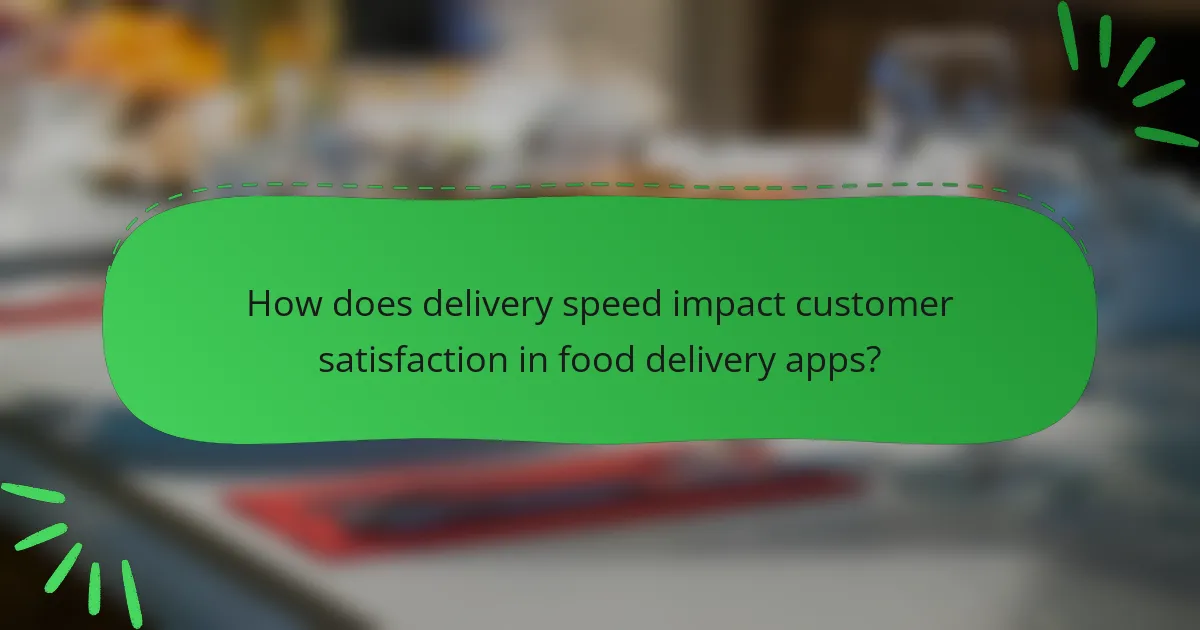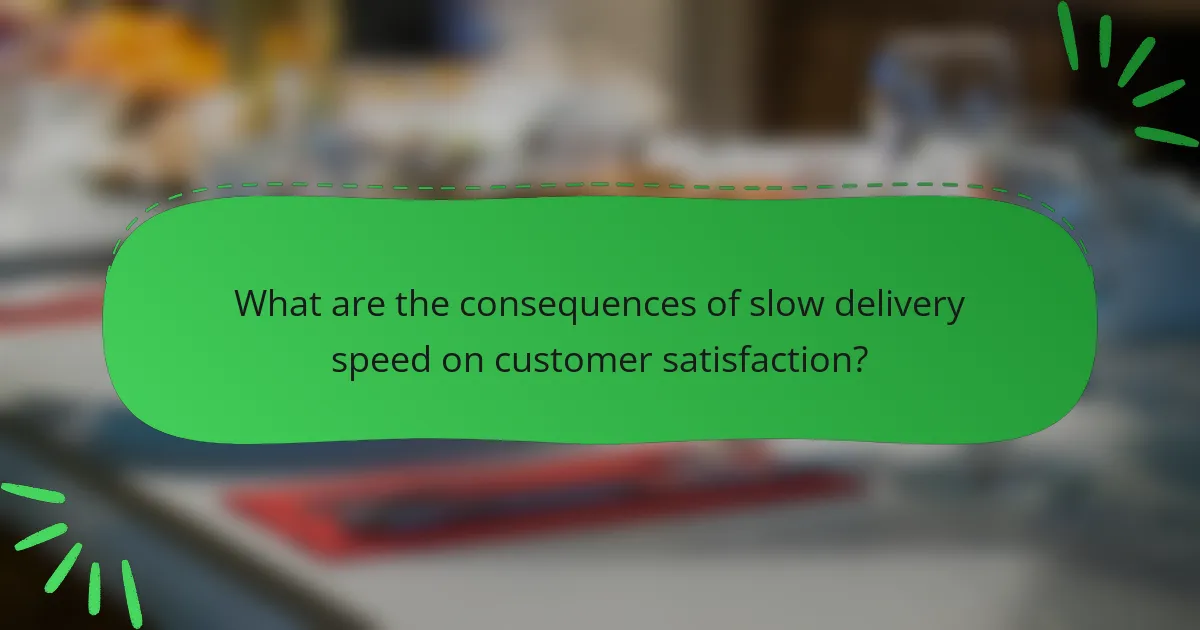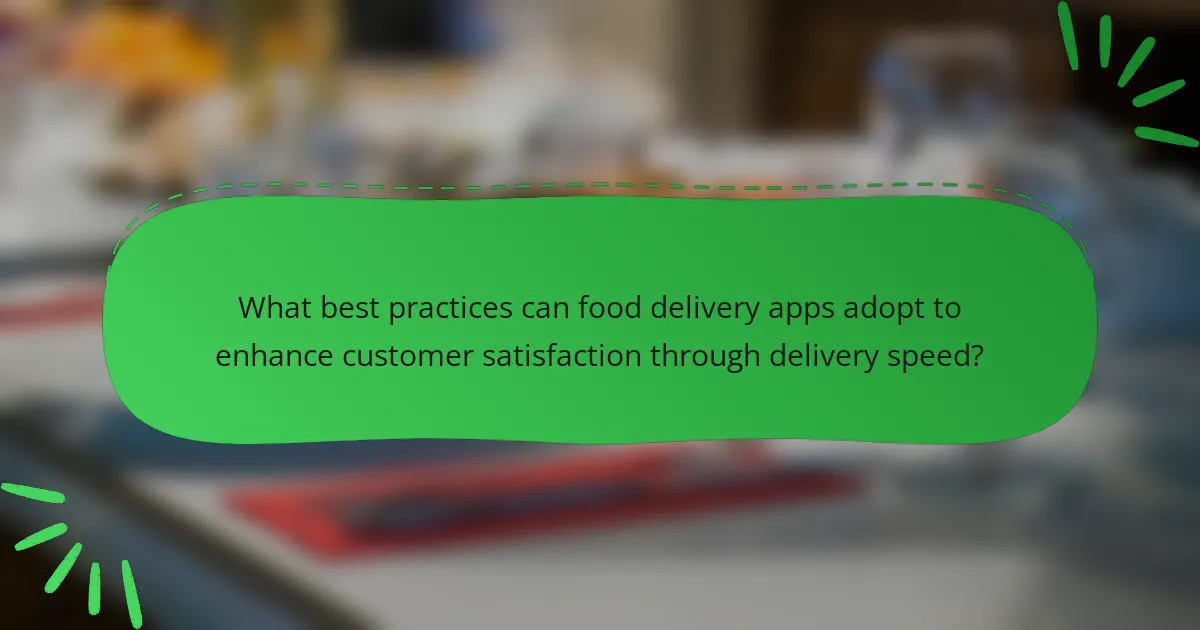Delivery speed is a critical factor influencing customer satisfaction in food delivery apps. Research indicates that 60% of customers prioritize speed when rating their overall delivery experience, with 70% stating that timely service is essential for repeat business. Long wait times can lead to frustration, negative reviews, and decreased customer loyalty. To improve delivery speed and enhance satisfaction, food delivery services can implement best practices such as optimizing routing algorithms, employing real-time tracking, increasing delivery personnel, providing accurate estimated delivery times, partnering with local restaurants, and utilizing customer feedback for continuous improvement. These strategies collectively contribute to a more efficient delivery process and higher customer retention.

How does delivery speed impact customer satisfaction in food delivery apps?
Delivery speed significantly impacts customer satisfaction in food delivery apps. Faster delivery times lead to higher satisfaction levels among users. Research shows that 60% of customers rate speed as a critical factor in their overall experience. Long wait times can frustrate customers and lead to negative reviews. A study by Statista indicates that 70% of users prioritize quick delivery over other features. When deliveries exceed estimated times, customer loyalty decreases. Additionally, timely deliveries enhance the likelihood of repeat orders. Overall, delivery speed is a key determinant of customer satisfaction in the food delivery sector.
What factors contribute to delivery speed in food delivery apps?
Delivery speed in food delivery apps is influenced by several key factors. The distance between the restaurant and the customer plays a significant role. Shorter distances typically result in quicker delivery times. The availability of delivery personnel also impacts speed. More drivers in a given area can reduce wait times.
Order preparation time is another critical factor. Restaurants that prepare food quickly can expedite the overall delivery process. Traffic conditions can also affect delivery speed. Heavy traffic or road closures can lead to delays.
Weather conditions are an additional consideration. Adverse weather can slow down delivery drivers. The efficiency of the app’s routing algorithm also contributes to speed. Advanced algorithms can optimize delivery routes to minimize travel time.
Finally, the time of day can influence delivery speed. Peak hours often result in longer wait times due to increased demand. These factors collectively determine how quickly food is delivered to customers.
How do order preparation times affect delivery speed?
Order preparation times directly impact delivery speed. Longer preparation times delay the overall delivery process. When a restaurant takes more time to prepare food, the delivery driver waits longer before starting the journey. According to a study by the Journal of Food Service Business Research, a 10-minute increase in preparation time can lead to a 15% increase in total delivery time. This delay can frustrate customers, leading to decreased satisfaction. Efficient order preparation is crucial for timely deliveries. Reducing preparation times can enhance overall delivery speed and improve customer experiences.
What role does distance play in delivery speed?
Distance significantly impacts delivery speed. Longer distances typically lead to increased delivery times. This is due to factors such as travel time and potential traffic delays. A study by the Journal of Business Logistics found that delivery time increases by an average of 1.5 minutes for every mile. Therefore, shorter distances generally result in faster deliveries. Efficient routing and local availability can also enhance speed. In contrast, longer distances may require more complex logistics. This relationship between distance and speed is crucial for customer satisfaction in food delivery apps.
How do traffic conditions influence delivery speed?
Traffic conditions significantly influence delivery speed. Congested roads lead to slower travel times for delivery vehicles. Studies show that increased traffic can delay deliveries by up to 30%. Traffic signals and roadworks further exacerbate these delays. In urban areas, peak hours often see heightened congestion. This results in longer routes and increased fuel consumption. Effective route planning can mitigate some delays. However, unpredictable traffic patterns remain a challenge for timely deliveries.
Why is customer satisfaction important in the context of food delivery apps?
Customer satisfaction is crucial for food delivery apps because it directly impacts customer loyalty and retention. High levels of satisfaction lead to repeat usage of the app. Satisfied customers are more likely to recommend the service to others. According to a study by the American Customer Satisfaction Index, higher customer satisfaction correlates with increased revenue for companies. Additionally, food delivery apps with positive reviews tend to attract more users. This creates a competitive advantage in a crowded market. Ultimately, customer satisfaction influences the overall success and growth of food delivery services.
What metrics are used to measure customer satisfaction in food delivery apps?
Customer satisfaction in food delivery apps is typically measured using several key metrics. These metrics include Net Promoter Score (NPS), Customer Satisfaction Score (CSAT), and Customer Effort Score (CES). NPS gauges customer loyalty by asking how likely users are to recommend the service. CSAT measures overall satisfaction with a specific order or experience. CES assesses how easy it was for customers to complete their tasks, such as placing an order or receiving delivery. Additionally, delivery time and order accuracy are critical metrics. Studies show that faster delivery times correlate with higher customer satisfaction. According to a report by McKinsey, 70% of consumers consider delivery speed a primary factor in their satisfaction with food delivery services.
How does customer satisfaction affect repeat business for food delivery apps?
Customer satisfaction significantly influences repeat business for food delivery apps. High levels of satisfaction lead to increased loyalty and frequency of orders. Satisfied customers are more likely to recommend the app to others. Research indicates that 70% of customers will return to a service that meets their expectations. Additionally, positive experiences can enhance brand reputation. A study by the Journal of Marketing Research found that a 5% increase in customer satisfaction can lead to a 25% increase in repeat purchases. Therefore, food delivery apps must prioritize customer satisfaction to drive repeat business effectively.

What are the consequences of slow delivery speed on customer satisfaction?
Slow delivery speed negatively impacts customer satisfaction. Customers expect timely service in food delivery. Delays can lead to frustration and disappointment. According to a study by McKinsey, 70% of customers cite delivery speed as a key factor in their satisfaction. Slow deliveries can result in negative reviews and loss of repeat business. Customers may choose competitors with faster service. This can harm a brand’s reputation and market share. Overall, slow delivery speed directly correlates with decreased customer loyalty.
How do delays in delivery impact customer perceptions?
Delays in delivery negatively impact customer perceptions. Customers expect timely service, and delays can lead to frustration. Research indicates that 70% of consumers feel dissatisfied when deliveries are late. This dissatisfaction can result in negative reviews and decreased loyalty. Customers may perceive the brand as unreliable. They often compare delivery times with competitors. A delay can also diminish the perceived value of the product. Overall, timely delivery is crucial for maintaining positive customer perceptions.
What are the emotional responses customers have to late deliveries?
Customers experience frustration and disappointment in response to late deliveries. This emotional response often stems from unmet expectations regarding delivery times. Customers may feel anxious about the delay, particularly if they are waiting for food during a specific time, such as a meal. Anger can also arise, especially if the delay is significant or if the customer has experienced repeated issues.
In some cases, customers might feel helpless, as they rely on the service for timely delivery. Trust in the delivery service can diminish due to late deliveries, leading to potential loss of loyalty. According to a survey by Statista, 61% of customers reported they would switch to a different service after experiencing late deliveries. These emotional responses can significantly impact overall customer satisfaction and future purchasing decisions.
How do slow deliveries affect overall ratings and reviews?
Slow deliveries negatively impact overall ratings and reviews. Customers expect timely service in food delivery. Delays can lead to dissatisfaction and frustration. Research shows that 70% of customers rate delivery speed as crucial. A slow delivery can result in lower star ratings. Negative reviews often cite delivery time as a primary issue. Consistent delays can damage a brand’s reputation. Ultimately, slow deliveries correlate with decreased customer loyalty.
What strategies can food delivery apps implement to improve delivery speed?
Food delivery apps can implement several strategies to improve delivery speed. Optimizing route algorithms can significantly reduce delivery times. These algorithms analyze traffic patterns and suggest the fastest routes. Partnering with local restaurants can also enhance speed. This proximity allows for quicker food preparation and pickup.
Utilizing a larger fleet of delivery drivers can decrease wait times. More drivers mean better coverage and faster delivery capabilities. Implementing real-time tracking can help manage customer expectations. Customers appreciate knowing their order status and estimated arrival time.
Incentivizing drivers for faster deliveries can motivate prompt service. Offering bonuses for timely deliveries encourages efficiency. Streamlining order management systems can eliminate delays. Efficient systems ensure orders are processed and dispatched quickly.
Investing in technology, like automated dispatch systems, can improve coordination. Automation reduces human error and speeds up the delivery process. Training drivers on efficient delivery practices is also beneficial. Well-trained drivers can navigate routes more effectively.
These strategies collectively enhance delivery speed, which is crucial for customer satisfaction. Studies show that faster deliveries lead to higher customer retention rates.
How can technology enhance delivery logistics?
Technology enhances delivery logistics by improving efficiency and accuracy. Automated routing software optimizes delivery paths, reducing travel time. Real-time tracking systems provide updates to customers and drivers. This transparency increases customer satisfaction. Drones and autonomous vehicles are emerging as innovative delivery methods. They can operate faster than traditional vehicles. Data analytics helps businesses forecast demand and manage inventory effectively. Companies like Amazon use these technologies to streamline operations. Overall, technology significantly boosts the speed and reliability of delivery logistics.
What operational changes can be made to streamline the delivery process?
Implementing route optimization software can significantly streamline the delivery process. This technology analyzes traffic patterns and delivery locations. It enables drivers to take the most efficient routes. Reducing travel time directly impacts delivery speed. Additionally, increasing communication between drivers and dispatch improves coordination. This ensures timely updates and adjustments during deliveries. Training staff on efficient packing methods can also enhance speed. Properly packed orders minimize delays during transit. Finally, utilizing real-time tracking systems provides transparency. Customers appreciate knowing the status of their orders, which boosts satisfaction.

What best practices can food delivery apps adopt to enhance customer satisfaction through delivery speed?
Food delivery apps can enhance customer satisfaction through delivery speed by implementing several best practices. First, optimizing route algorithms can significantly reduce delivery times. Efficient routing minimizes travel distance and time, ensuring quicker deliveries. Second, employing real-time tracking allows customers to monitor their orders. This transparency builds trust and keeps customers informed. Third, increasing the number of delivery personnel can reduce wait times. More drivers mean faster pickup and delivery processes. Fourth, offering estimated delivery times based on historical data can manage customer expectations. Accurate time estimates improve satisfaction. Fifth, establishing partnerships with local restaurants can streamline order preparation and pickup. Closer proximity leads to quicker service. Lastly, utilizing customer feedback to identify bottlenecks in the delivery process can drive continuous improvement. Addressing issues highlighted by customers enhances overall service quality. These practices collectively contribute to a more efficient delivery system, ultimately boosting customer satisfaction.
How can communication improve customer satisfaction during the delivery process?
Effective communication can significantly improve customer satisfaction during the delivery process. Clear updates about delivery status keep customers informed and reduce anxiety. For example, a study by the Journal of Business Research found that timely notifications can enhance the perception of service quality. Providing estimated delivery times allows customers to plan accordingly. Engaging with customers through direct communication channels can address concerns promptly. This proactive approach fosters trust and loyalty. According to a survey by PwC, 73% of consumers cite customer experience as an important factor in their purchasing decisions. Thus, effective communication is essential for enhancing customer satisfaction in food delivery services.
What information should be provided to customers about their order status?
Customers should be informed about their order status through several key updates. These updates include confirmation of order placement. Notifications about estimated delivery time are essential. Customers should receive alerts when their order is being prepared. Updates on when the order is out for delivery are also important. Tracking information should be provided for real-time location of the delivery. Notifications about any delays or changes in delivery time should be communicated promptly. Finally, confirmation of order delivery should be sent to the customer. These details enhance transparency and improve customer satisfaction in food delivery apps.
How can proactive customer service mitigate dissatisfaction from delays?
Proactive customer service can mitigate dissatisfaction from delays by anticipating customer concerns and addressing them before they escalate. For instance, informing customers about potential delays in advance helps manage expectations. This approach reduces frustration, as customers feel informed rather than ignored. Additionally, offering solutions, such as discounts or compensation, can further alleviate dissatisfaction. Research indicates that 70% of customers prefer being informed about issues proactively rather than waiting for them to occur. This strategy fosters trust and loyalty, enhancing overall customer satisfaction.
What tips can customers follow to ensure a better delivery experience?
Customers can ensure a better delivery experience by providing accurate information. They should enter correct addresses and contact details. This reduces the chances of delays. Customers should also track their orders in real-time. This allows them to anticipate delivery times. Being available at the delivery location is crucial. It prevents missed deliveries and additional wait times. Customers can communicate special instructions to the delivery personnel. Clear guidance enhances the delivery process. Lastly, providing feedback after delivery helps improve service. This feedback is valuable for future improvements.
How can customers choose the best time for ordering to minimize delays?
Customers can choose the best time for ordering by avoiding peak hours. Peak hours typically occur during lunch and dinner times when demand is highest. Ordering during off-peak times can lead to shorter wait times. Research indicates that food delivery apps experience increased delays during busy periods. For instance, a study found that orders placed between 6 PM and 8 PM face longer delivery times. Additionally, customers should consider local events or holidays that may increase demand. By being mindful of these factors, customers can minimize delays effectively.
What should customers know about peak delivery times and their impact on speed?
Peak delivery times significantly affect delivery speed. During these times, demand for deliveries increases, causing delays. Restaurants and delivery services may experience higher order volumes. This can lead to longer wait times for customers. According to studies, peak hours can increase delivery times by 20-30%. Customers should expect slower service during lunch and dinner rushes. Awareness of these peak times can help manage expectations. Understanding this can enhance overall satisfaction with the service.
The main entity of the article is delivery speed in food delivery apps. The article examines how delivery speed directly influences customer satisfaction, highlighting that faster delivery times correlate with higher satisfaction levels and increased customer loyalty. It identifies key factors affecting delivery speed, such as distance, order preparation time, traffic conditions, and weather. Additionally, the article discusses the importance of customer satisfaction metrics, the emotional responses to delays, and strategies for improving delivery speed, ultimately emphasizing the critical role of timely deliveries in enhancing customer experiences and driving repeat business.
